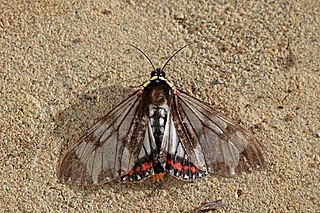Related Research Articles

Raijū is a legendary creature from Japanese mythology.

The golden-hooded tanager is a medium-sized passerine bird. This tanager is a resident breeder from southern Mexico south to western Ecuador.

The masked palm civet, also called the gem-faced civet, is a palm civet species native to the Indian subcontinent and Southeast Asia. It has been listed as least concern on the IUCN Red List since 2008 as it occurs in many protected areas, is tolerant to some degree of habitat modification, and widely distributed with presumed large populations that are unlikely to be declining.

The lemon dove or cinnamon dove is a species of bird in the pigeon family Columbidae found in montane forests of sub-Saharan Africa. The São Tomé lemon dove is usually treated as a subspecies. The lemon dove has a generally brownish-grey plumage with a cinnamon brown breast. Males have a greenish-glossed neck and white markings on the head, and females and juveniles are rather more brown and have grey facial markings. This dove is a common species, and the International Union for Conservation of Nature has rated its conservation status as being of "least concern".

The black-faced firefinch is a common species of estrildid finch found in Africa. It has an estimated global extent of occurrence of 2,100,000 km2.

The golden loaches (Sabanejewia) are a genus of ray-finned fish in the family Cobitidae.

The Italian loach is a species of ray-finned fish in the family Cobitidae. It is found only in Italy. It is threatened by habitat loss.
Grandisonia larvata is a species of caecilian in the family Indotyphlidae, endemic to the Seychelles islands of Mahé, Praslin, La Digue, and Silhouette.

The Sunda cuckooshrike is a species of bird in the family Campephagidae. It is found in Indonesia and Malaysia, where it occurs on Borneo, Sumatra and Java. Its natural habitat is subtropical or tropical moist montane forest.

Dysschema is a genus of tiger moths in the family Erebidae. The genus was erected by Jacob Hübner in 1818. The genus contains some of the more showy moths of the southwestern United States.
The Indotyphlidae are a family of common caecilians found in Africa, Seychelles and India. Like other caecilians, they superficially resemble worms or snakes.
Helcogramma larvata is a species of triplefin blenny in the genus Helcogramma. It was described by Ronald Fricke and John E. Randall in 1992. This species has only been recorded from North Male Atoll in the Maldives where the only known specimens were found in a shallow lagoon with a maximum depth of 5 metres (16 ft) and a sandy bottom.
Dysschema larvata is a moth of the family Erebidae. It was described by Francis Walker in 1856. It is found in Brazil.

Lamiini is a tribe of longhorn beetles of the subfamily Lamiinae.
Peribasis is a genus of longhorn beetles of the subfamily Lamiinae, containing the following species:
Peribasis helenor is a species of beetle in the family Cerambycidae. It was described by Newman in 1851, originally under the genus Monohammus. It is known from Malaysia, India, and Sumatra.

Peribasis pubicollis is a species of beetle in the family Cerambycidae. It was described by Francis Polkinghorne Pascoe in 1866. It is known from Singapore, Borneo, Bhutan and Malaysia.
Timbuka is a genus of anyphaenid sac spiders first described by Antônio Brescovit in 1997.
Prunus rufoides, called Diel's cherry, the tawny bark cherry, and in Chinese: 尾叶樱桃, the tailed-leaf cherry, is a species of cherry native to China, preferring to grow at 500–1400 m above sea level, but reaching 1800 m. The fruits are eaten by masked palm civets and the fruits, leaves and buds are eaten by gray snub-nosed monkeys.
Bomis is a genus of crab spiders that was first described by Ludwig Carl Christian Koch in 1874.
References
- ↑ BioLib.cz - Peribasis larvata. Retrieved on 8 September 2014.